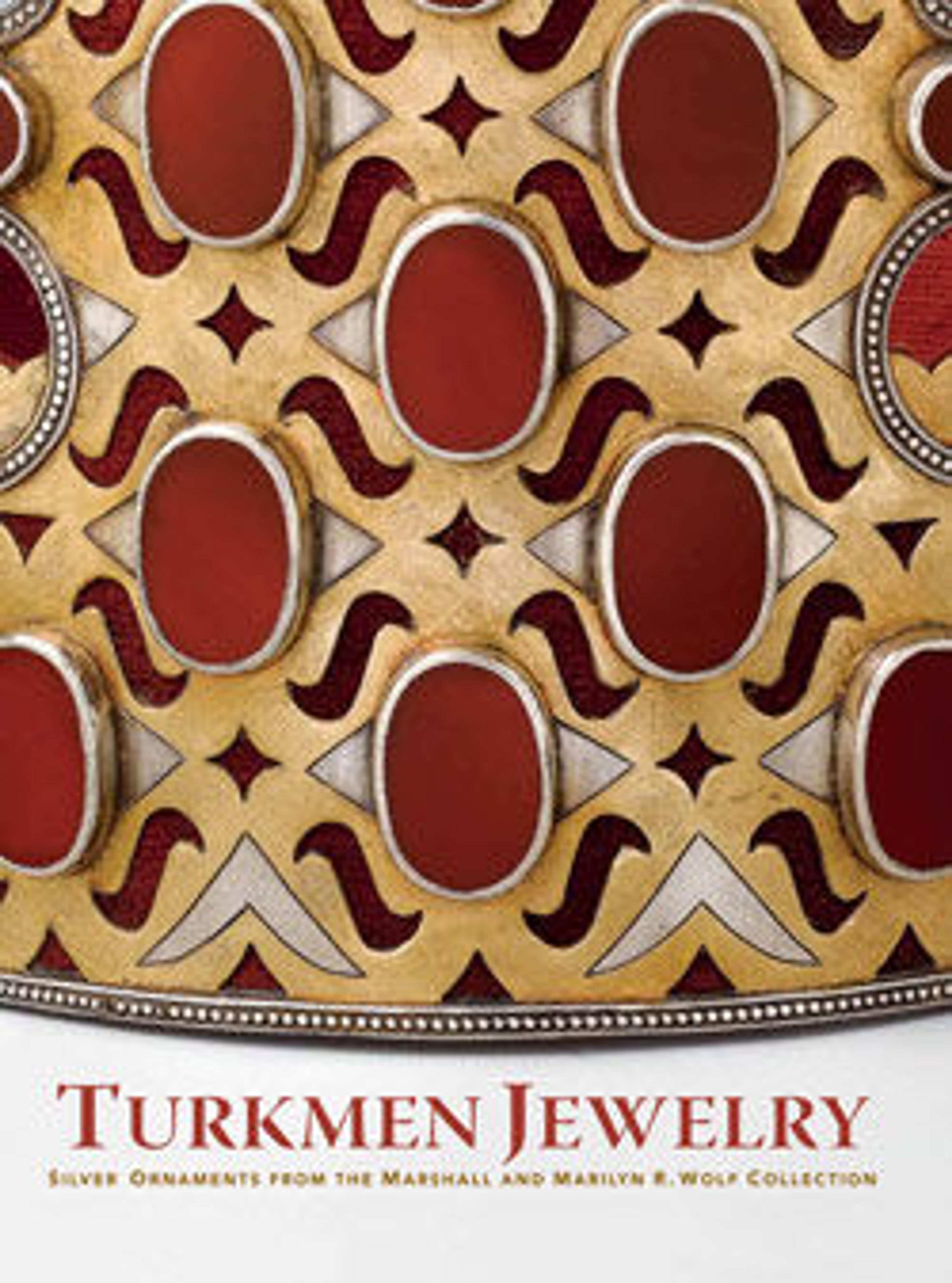Dorsal Plait Ornament
Yomut Dorsal Plait Ornaments (MMA 2011.584.7, MMA 2005.443.6, MMA 2009.530.12, and MMA 2017.693.4)
Dorsal ornaments created by the Yomut tribe are particularly original and appealing. In nos. 2011.584.7 and 2005.443.6 modest materials are combined with great artistry to create a sumptuous display as lavish as any achieved with more precious stones or pure gold. Both of these examples, as well as nos. 2009.530.12 and 2017.693.4, display numerous variations in the configuration of the coins. They also feature a wide diversity of shapes, including cordiform ornaments, roundels, floral forms, and semispherical bells, and a sense of volume introduced by the boxlike compartments.
Particularly intriguing is the way coins are used in these pieces. In no. 2011.584.7 the ten coins are not visible, since they serve as the base for gilded, embossed plaques, which is rather unusual, while no. 2005.443.6 displays the more typical use of coins as decorative elements in and of themselves. Close examination by the Museum’s conservator has revealed that the coins in the latter piece (see photo of back in this volume) were flattened at both ends to adapt them to the ladderlike construction.[4]
The coins utilized in these two pieces are Persian, dating from ca. 1848–1907. The use of such coins for decoration reflects the Turkmen’s success as slave traders and proclaims their pride in their prowess as warriors.
The jewelry produced by local silversmiths shares a decorative vocabulary with horse trappings, which they also created,[5] and no. 2005.443.6 exemplifies the interrelationship between these two types of ornaments in the Turkmen tradition.
Layla S. Diba in [Diba 2011]
Footnotes:
4. Jean-François de Lapérouse, conversation with the author, 2006.
5. Beresneva, L. The Decorative and Applied Art of Turkmenia. Leningrad, 1976, fig. 103, and Firouz, Iran Ala. Silver Ornaments of the Turkoman. Tehran, 1978, p. 44, fig. 69, for examples of Teke leather horse trappings decorated with similar stamped embossed roundels.
Dorsal ornaments created by the Yomut tribe are particularly original and appealing. In nos. 2011.584.7 and 2005.443.6 modest materials are combined with great artistry to create a sumptuous display as lavish as any achieved with more precious stones or pure gold. Both of these examples, as well as nos. 2009.530.12 and 2017.693.4, display numerous variations in the configuration of the coins. They also feature a wide diversity of shapes, including cordiform ornaments, roundels, floral forms, and semispherical bells, and a sense of volume introduced by the boxlike compartments.
Particularly intriguing is the way coins are used in these pieces. In no. 2011.584.7 the ten coins are not visible, since they serve as the base for gilded, embossed plaques, which is rather unusual, while no. 2005.443.6 displays the more typical use of coins as decorative elements in and of themselves. Close examination by the Museum’s conservator has revealed that the coins in the latter piece (see photo of back in this volume) were flattened at both ends to adapt them to the ladderlike construction.[4]
The coins utilized in these two pieces are Persian, dating from ca. 1848–1907. The use of such coins for decoration reflects the Turkmen’s success as slave traders and proclaims their pride in their prowess as warriors.
The jewelry produced by local silversmiths shares a decorative vocabulary with horse trappings, which they also created,[5] and no. 2005.443.6 exemplifies the interrelationship between these two types of ornaments in the Turkmen tradition.
Layla S. Diba in [Diba 2011]
Footnotes:
4. Jean-François de Lapérouse, conversation with the author, 2006.
5. Beresneva, L. The Decorative and Applied Art of Turkmenia. Leningrad, 1976, fig. 103, and Firouz, Iran Ala. Silver Ornaments of the Turkoman. Tehran, 1978, p. 44, fig. 69, for examples of Teke leather horse trappings decorated with similar stamped embossed roundels.
Artwork Details
- Title:Dorsal Plait Ornament
- Date:late 19th–early 20th century
- Geography:Attributed to Central Asia or Iran
- Medium:Silver; fire-gilded, with stamped and applied decoration, Persian silver coins, table-cut carnelians, loop-in-loop chains, bells, and cordiform pendants
- Dimensions:H. 22 3/8 in. (56.8 cm)
W. 5 3/4 in. (14.7 cm) - Classification:Jewelry
- Credit Line:Gift of Marshall and Marilyn R. Wolf, 2005
- Object Number:2005.443.6
- Curatorial Department: Islamic Art
More Artwork
Research Resources
The Met provides unparalleled resources for research and welcomes an international community of students and scholars. The Met's Open Access API is where creators and researchers can connect to the The Met collection. Open Access data and public domain images are available for unrestricted commercial and noncommercial use without permission or fee.
To request images under copyright and other restrictions, please use this Image Request form.
Feedback
We continue to research and examine historical and cultural context for objects in The Met collection. If you have comments or questions about this object record, please contact us using the form below. The Museum looks forward to receiving your comments.
